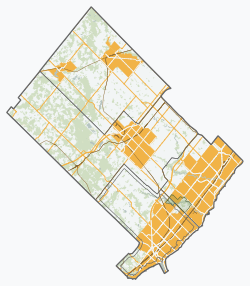History
Around 1820 James McNab and his family arrived; McNab was a United Empire Loyalist and had fought in the War of 1812. The family raised sheep and built a grist and a saw mill on the Credit River. Some of their wood was shipped to England for use as masts on naval ships. [1] Flour mills also opened in this area; the largest one operated until 1930 when it was destroyed in a fire. [1]
In 1836 the post office was established. Previously, the settlement had been called McNabsville and McNab's Mill. In 1838, the mills were sold to Peter Adamson. In 1851, the Guelph Plank Road passed through this area and by 1856 the Grand Trunk Railway had arrived. The latter was useful for shipping goods from this area. [1]
In 1846, the settlement had a population of about 200 inhabitants, served by two churches, various tradesmen, a gristmill, an oatmeal mill, a distillery, two stores and a tavern. [2]
Norval became a thriving village, complete with a broom factory, ashery, bakery, woollen and flax mills, carriage works, a blacksmith and harness shops, brass foundry, general stores, several hotels, a Mechanics' Institute and an Orange Lodge. It was a main stop on the stagecoach ride from Guelph to Toronto.
Upper Canada College's Norval Outdoor School is located nearby at 10444 Winston Churchill Boulevard. Acquired in 1913, it was established in the property after 1935.
Author Lucy Maud Montgomery, who wrote the Anne of Green Gables series, lived in Norval from 1926 to 1935 as her husband Reverend Ewan MacDonald was minister of the Norval Presbyterian Church (1851-2024). In her journal, Montgomery expressed her appreciation for the village’s natural beauty, and declared, “I love Norval as I have never loved any place save Cavendish, PEI. It is as if I had known it all my life". [3]
In 1954 the grist mill was destroyed by Hurricane Hazel. In 1972 the remaining structures were removed to expand Highway 7. Many historic buildings still stand in Norval. [1] [4]
This page is based on this
Wikipedia article Text is available under the
CC BY-SA 4.0 license; additional terms may apply.
Images, videos and audio are available under their respective licenses.



